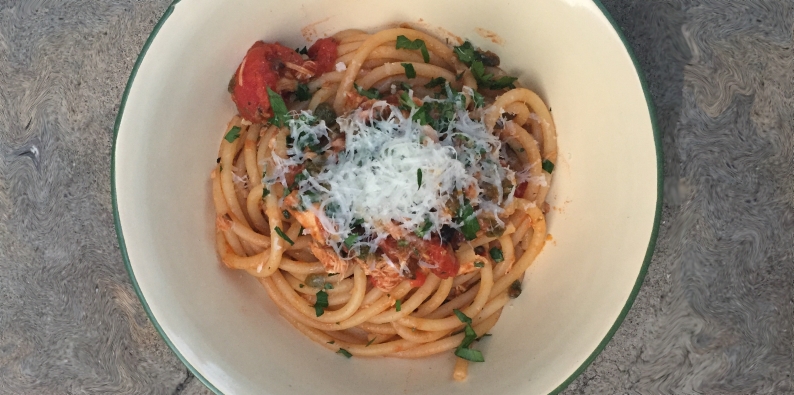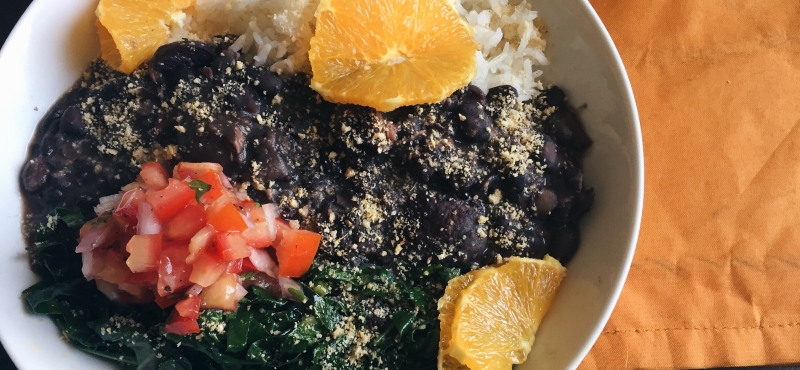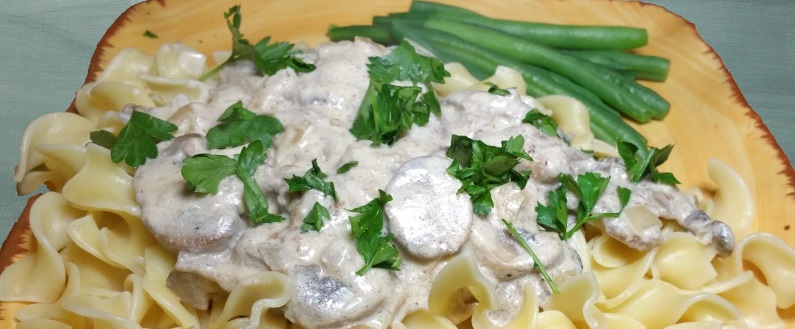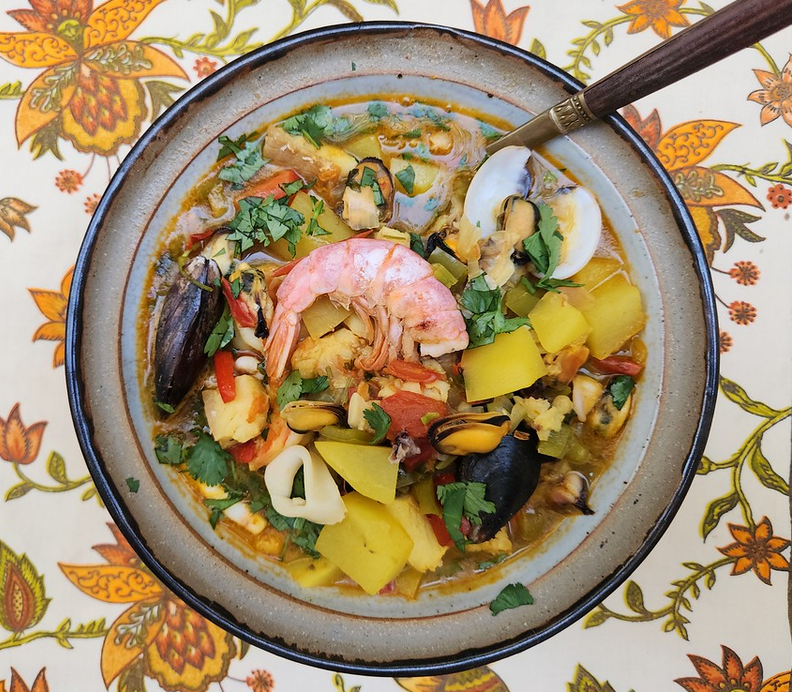
The name alla Puttanesca literally translates to "in the style of prostitutes." It's fair to say that with a name like that, any dish would have rumors swirling around it. There are various accounts of how the pungent, savory and impactful combination of sauce and pasta became associated with sex workers. Two of the most common stories, both of which I have heard from different sources, have to do with the brothels of Naples. The first claims that the dish, a seeming mishmash of common Neapolitan ingredients, was so easy to throw together that the courtesans would make large batches of the pasta in between their appointments to feed their co-workers. I tend to like the camaraderie that this story showcases; it's like the firehouse chili of mid-century Neapolitan brothels. The alternative courtesan-based story asserts that the pungent combination of capers, olives, anchovies, garlic and chili cooking would lure men off the street and into their clutches.
Additional references to alla puttanesca occur between the 1960s and 70s. According to the Grande dizionario della lingua italiana, the first reference to pasta alla puttanesca was a 1961 novel by Raffael la Capria, Ferito a Morte (The Mortal Wound), in which "spaghetti alla puttanesca come li fanno a Siracusa" is mentioned. This "pasta alla puttanesca like they make it in Syracuse" indicates a Sicilian rather than a Campanian (or specifically Neapolitan) origin.
The timeline indicated by La Capria's novel finds support in a study conducted by the Unione Industriali Pastali Italiani (Italian Pasta Makers Union), which claims that the dish became popular in the 1960s. Further evidence of its rise in the 60s and 70s are seen in American restaurant reviews and Italian cookbooks. In 1972, New York Times restaurant critic Jean Hewitt wrote about the dish in her review of Trattoria da Alfredo, referencing the pungent combination of garlic, olive, anchovy and tomato. A few years later, author Jeanne Carola Francesconi, in her tome "La cucina napoletana" (1977), claims that the sauce was an invention of painter Eduardo Maria Colucci, who concocted the sauce as a variation on pasta alla marinara (sailor-style pasta).
The final story details the origin of the name being philological and linguistic, rather than having any connection with brothels or courtesans. The co-owner of a popular Ischian restaurant named Rancio Fellone created the dish with leftover items in the kitchen. Restaurant owner Sandro Petti was entertaining guests at his home one evening when they asked him to cook them a meal. He looked in his private pantry to find nothing but some tomatoes, capers, olives and pasta. A friend reportedly told him to make "puttanata qualsiasi," or "whatever crap." The dish was so good that Petti opted to add it to the menu, but the name spaghetti alla puttanata sounded clunky, as puttanata is a noun and not an adjective like puttanesca. In the end, Petti chose to substitute puttanesca, as the words are related and it makes far more sense in Italian linguistics.
Even though the recorded examples of puttanesca all come from the mid-20th century, it is entirely possible that the brothel stories are rooted in truth. Tomatoes have existed in Italy since the 16th century and over the centuries they become an important part of the culinary landscape. A Neapolitan proto-puttanesca may have come into being long before the recorded examples.
The origin of spaghetti alla puttanesca remains shrouded in mystery. The only concrete facts are the vagueness of its inception and the delicious flavors contained in the sauce. Luckily, the dish's origin doesn't affect how it looks, tastes and smells when put on a plate in front of a hungry diner.
Ingredients:
- 1/2 pound dried spaghetti noodles
- Kosher salt
- 4 tablespoons extra virgin olive oil, plus extra for serving
- 6 medium garlic cloves, sliced
- 4-6 anchovy fillets, finely chopped
- 2-3 teaspoon red chili flakes
- 1/4 cup capers, drained and chopped
- 1/4 cup pitted black olives, chopped
- 1 cup whole peeled San Marzano tomatoes, crushed by hand
- 1/4 cup of flat leaf Italian parsley, minced
- Grated zest of half a lemon
- 2 tablespoons (1 ounce) grated Pecorino Romano cheese, plus more for serving
- Freshly ground black pepper, to taste
Preparation:
- Bring a pot of well-salted water to a boil and add the spaghetti. Cook 1 minute less than package directions and drain, reserving 1/4 cup of the pasta water.
- While water is coming up to a boil, combine oil, chili flakes, garlic and anchovies in a medium skillet over medium heat. Keep stirring the mixture until the garlic is lightly golden.
- Add capers and olives to the pan, stirring to combine and heat until lightly pungent.
- Stir in the tomatoes and bring the whole mixture to a bare simmer.
- Add the drained pasta and 2 tablespoons of pasta water to the simmering sauce. Increase the heat and bring the sauce/pasta mixture to a vigorous simmer.
- Toss the sauce and pasta until the noodles are coated. Cut the heat and stir in another tablespoon of olive oil, the Pecorino Romano, lemon zest and parsley.
- Season generously with black pepper and add a scant amount of salt if absolutely necessary; the dish should be plenty salty due to the capers, olives and anchovies. Serve with additional Pecorino Romano.
NOTE: Feel free to substitute any dry pasta for the spaghetti and adapt cooking times accordingly. You can also reduce the amount of red chili flakes.
Recipe and Photo by Liam Fox
- Details
- Hits: 3861

One of the most recognizable dishes of modern day Brazil is the rich stew known as feijoada. The term feijoada derives from the Portuguese word for bean, feijão, and this points to the common element in all variations of the dish.
Feijoada is one of the most iconic dishes in Brazilian cuisine, the rich dish of beans and sausages holds a specific place in weekly life for many Brazilians. A typical meal of feijoada has multiple parts. First there is the feijoada itself, a thick stew redolent with various meats, sausages and beans. The stew is always accompanied by a variety of side dishes. These include long grain white rice, thinly slices and sautéed collard greens, orange slices, a "vinaigrette" of tomatoes, onion, lime and parsley and prepared manioc (cassava) flour called farofa. The rice acts as a foil for the stew, the collard greens provide additional nutrition and a bitter component, the vinaigrette provides acid, the manioc texture and the oranges a bit of sweetness. Feijoada brasiliera is a complex amalgamation of all these ingredients and the flavors achieve a wonderful harmony. Due to the heartiness of the dish it is often eaten as a leisurely midday meal. In Sao Paolo restaurants typically serve feijoada as a special meal on Wednesdays whereas in Rio de Janeiro it is served on Fridays. While it is the national dish of Brazil, ingredients vary be region with black beans and various meats being popular in the south and red beans and vegetables common in the north.
Feijoada has it roots in the Iberian Peninsula. The first forms of feijoada reflect the wide extent of early Portuguese trade routes. Tomatoes and kidney beans from the Americas and spices from India and Indonesia feature prominently in this pork-based stew. Many of the ingredients found in present day versions were not available to Europeans until after 1500 and more likely weren't used until the 17th century or later. By this time bean dishes and heavily spiced items (like Morcilla, Chouriço) had become more ingrained in Portuguese food and thus items like feijoada became more common. The Brazilian version blends Portuguese, African and indigenous elements. Ingredients like black beans, tomatoes and cassava (also known as manioc) are nods to the bounty of the Amazon ecosystem and trade with Mesoamerica and the Andes. The European style sausages, citrus, vinegar and dried beef were all originally brought to the Americas by the Portuguese. Collard greens and rice are staples of West and Central African populations and arrived with the slave trade. All of these components are integral to the meal and event that is feijoada.
Some believe feijoada originated with the slaves in Brazil. Purportedly the dish was made from cheap ingredients (black beans, collards and rice) flavored with the leftovers and scraps of the master's household. This theory arose due to the traditional inclusion of pig's feet, ears, tails and other low status animal parts in feijoada found throughout Brazil. This theory, while plausible, has come under scrutiny in recent years due to studies concerning the cultivation of black beans in Brazil. Beans were a common staple among all strata of society. From rich European settlers to enslaved Africans, the black bean provided a steady, nutritious and accessible form of sustenance. More affluent populations would flavor the beans with meat and vegetables (like modern iterations of feijoada) whereas the poor would typically eat beans with a medley of rice and cassava flour. Modern versions feijoada embrace both styles, in a strange way, so the dish may have created a culinary bridge between social classes.
With the expansion of the Portuguese empire, feijoada became even more complex in ingredients. Contact with southern Africa, India and South East Asia brought new flavors and ingredients to the dish and those same trade routes resulted in bringing of feijoada to the entire world with each version reflecting the unique palates and cuisines of the places where it found a home. Brazilian feijoada is the delicious and famous starting point, but myriad versions exist all waiting to be enjoyed.
Ingredients:
For the rice, collards and beans:
- 1/2 pound Portuguese linguica sausage, sliced
- 1/4 pound paio sausage, sliced
- 1/4 pound Brazilian carne seca, soaked in cold water for 15 minutes
- 1/4 pound salt pork, cubed
- 1/4 pound smoked thick cut bacon, chopped
- 1 pound black beans, soaked overnight
- 6 dried bay leaves
- 8 cloves of garlic, crushed, plus 1/4 cup minced
- 10 collard green leaves, stemmed and sliced very thinly
- 2 cups of long grain white rice, rinsed and cooked in a rice cooker
- 3 tablespoons vegetable oil (or olive oil)
- Salt and Pepper to taste
For the vinaigrette and serving:
- 2 Roma tomatoes, cored and chopped
- 1 shallot, finely chopped
- 1 ounce lime juice
- 1/4 cup parsley, chopped
- 1/4 cup cilantro, chopped
- 1/4 cup red wine vinegar
- 1/4 cup good olive oil
- 1/4 cup prepared cassava flour (farofa)
- 1 orange, peeled and thinly sliced for garnish
Preparation:
- Add salt pork and bacon to an 8 quart stock pot or Dutch oven over medium heat and cook until fat begins to render (about 5 minutes).
- Add the remaining meat to the pot and brown over medium heat for an additional 8-10 minutes.
- Add beans, crushed garlic, bay leaves and enough water to cover and bring to a boil.
- Drop the heat to a simmer and allow the beans to cook until tender (approximately 1.5 - 2 hours).
- While the beans are cooking, mix the tomato, parsley, cilantro, shallot, vinegar, lime juice, oil and a pinch of salt and pepper in a small bowl. Set aside.
- On medium heat 3 tablespoon of oil in a large sauté pan or skillet and add the garlic.
- Fry, stirring constantly, until the garlic is fragrant and add the collard greens, salt and pepper.
- Cook the greens until leaves turn a bright green and soften (about 4 -5 minutes).
- Serve the dish on a large plate with rice and collards on opposite sides with the feijoada in the middle. Garnish with farofa, vinaigrette and orange slices.
NOTE: Paio, carne seca and prepared farofa can all be purchased at Brazil by the Bay market. This is the best place to find these items. They sell pre-portioned packs of meat for feijoada.
Recipe and photos by Liam Fox
- Details
- Hits: 3626

Mexican Pozole Rojo , or red pozole, a fiery corn-based dish that tantalizes the taste buds and warms the body. There is a considerable amount of preparation involved, so pozole is considered a special treat made for birthdays, Independence Day, Christmas and other holidays. Pozole has its origins in pre-Columbian traditions. As detailed in the Florentine Codex*, Aztecs and other Mesoamericans perceived maize as a sacred plant connected to humanity's origin. According to lore, the gods formed human beings out of masa, thus linking it to the basis of life itself. According to the Florentine Codex after ritual sacrifice, a common religious practice for the ancient Aztecs, the body would be broken down, cooked into pozole and consumed by the community as an act of religious communion. Presumably, after the Spanish outlawed cannibalism in Mesoamerica, alternatives were explored, leading to new recipes with chicken and pork. While the origin is fascinating, I for one am glad I get to enjoy this delicious soup in its modern iteration.
>The Spanish term pozole comes from the Nahuatl word for hominy, an ingredient that sits at the center of Mexican cuisine. The alkali-treated corn kernels are the basis for masa harina, the corn flour that is used to make tortillas and tamales. The treating process, known as nixtamalization, allows necessary nutrients like niacin and calcium to be absorbed by the human body.
In addition to hominy, pozole typically contains pork (though other meats are also used) and various chilies, and is accompanied by a multitude of garnishes. Shredded green cabbage, diced onion, tostadas, avocado, cilantro, oregano, radish and lime really round out the flavors in the bowl.
Three types of pozole are common: red, white and green. All three of these are riffs on the simple concept of hominy and broth. Red pozole takes its color and flavor from dried red chilies like ancho and guajillo, which are softened and then ground into a paste. Green pozole uses ingredients like tomatillos, epazote, fresh green chilies, cilantro and pepitas to form a rich and fresh soup. White pozole is the most traditional preparation as it forgoes the red or green ingredients in favor of hearty simplicity.
The following recipe is a variation on the classic red pozole. Traditionally, a bone-in piece of meat would be boiled with aromatics to produce a broth. I instead roast boneless pork shoulder and make a simple pork stock separately. This produces tender pork and a rich, flavorful stock. Feel free to use whichever method suits your personal preference. Most, if not all, ingredients can be found at a Mexican or Latin American grocery store such as Northgate Market or Pancho Villa Supermarket.
Cook's note: Like most recipes that call for marinating meats, the initial preparation for this dish is best done a day before. At the very least the meat should be marinated for an hour, but 12 to 24 hours is better.
*Editor's notes: The Florentine Codex is the best preserved part of a larger 12 volume codex now known as the "Historia general de las cosas de la Nueva Espa&ntilda;a" (The General History of the Things of New Spain). Originally published in 1569, the text is known as the Florentine Codex because it is held in Medicea Laurenziana Library in Florence, Italy
The compiler of the work was Bernardino de Sahagún, a Jesuit priest and early ethnographer who learned Nahuatl and spent more than 50 years studying Aztec beliefs, culture and history. Sahagún, whose primary goal was to convert indigenous people to Catholicism, held rather strong opinions on Aztec cultural practices and beliefs, greatly admiring some while despising others. It should be noted that considerable research and scholarly writing has challenged many post-contact reports regarding the extent of cannibalism, so the veracity of Sahagún's (who again was most interested in converting Aztecs to Catholocism) references to cannibalism among Aztecs, remains in question. His scholarly method, however, was pioneeringly ethnographic.
The text of the Florentine Codex is bilingual with Spanish on the left-hand side of each page phonetically transcribing Nahuatl, which is written using Latin letters on the right. The illustrations and much of the text were created by Aztec students, village elders and artists. The entire Florentine Codex has been digitally scanned in high resolution and can be found here. The quality of the scan is exquisite and digitally leafing through the pages is beyond thrilling—even if you don't read Spanish or Nahuatl.
Ingredients:
Chile paste:
- 4 Ancho chilies, seeded and stemmed
- 4 Guajillo chilies seeded and stemmed
- 4 Árbol chilies, seeded and stemmed
- Water to cover
Pork broth:
- 2 pigs feet, halved (ask your butcher to do this)
- 1 pound pork neck bones
- 1/2 medium onion
- 1 small head of garlic
- 3 bay leaves, dried
- 1 teaspoon black peppercorns, toasted
- 2 teaspoons smoked paprika
- 2 teaspoons Mexican oregano
- 2 tablespoons kosher salt
Roast pork:
- 1 1/2 pounds pork shoulder, deboned or boneless
- 1 tablespoon Kosher salt
- 1 tablespoon Achiote powder
- 4 garlic cloves, minced
- 8 ounces fresh orange juice
- 4 ounces fresh lime juice
Finishing and serving:
- 15 ounces can-prepared hominy
- Tostadas
- Avocado, sliced
- White onion, diced
- Radishes, thinly sliced
- Green cabbage, shredded
- Cilantro, chopped
- Lime wedges
Preparation:
- The day before cooking, combine fruit juices, garlic, salt and achiote in a bowl, mixing thoroughly.
- Place the pork shoulder into a gallon-sized bag and add the marinade. Let the mixture sit overnight in the refrigerator, turning once.
- The next day, remove the pork from the refrigerator and let it sit at room temperature for 1 hour.
- Forty-five minutes after the pork is removed from the refrigerator, preheat the oven to 300 degrees Fahrenheit.
- Place the pork on a wire rack over a sheet tray and roast in the oven for 4 hours or until pork is very tender.
- Remove from the oven and let rest for about 30 minutes before shredding.
- Heat a small skillet over medium-low heat until warm and then add the chilies.
- Toast the chilies, turning frequently, until fragrant and beginning to blister in places: approximately 2 minutes for the Árbol chilies and 4-5 for the Ancho and Guajillo.
- Transfer the chilies to a small saucepan and cover with water. Bring the pot to a boil and cook the chilies for 3 minutes.
- Add the chilies, their boiling liquid and 1 teaspoon of kosher salt to a blender and blend until smooth. A thick red paste should form.
- In a large heavy bottom stock pot or Dutch oven, place the pork bones and feet. Cover with cold water and bring to a boil.
- Once boiling, cut the heat, drain and thoroughly wash the bones in running water. Rinse the pot of any sediment or residue.
- Return the cleaned pork bones and feet to the pot. Add the onion, garlic, paprika, peppercorns, bay leaves, salt and oregano and enough water to cover.
- Bring the pot to a rolling boil and skim any foam that forms on the surface. Boil for 15-20 minutes and then lower the heat to a bare simmer and cover the pot.
- Simmer the mixture for another 2 to 3 hours, adding water as necessary to keep the bones covered.
- Once the liquid has become infused with the spices and the pork has a lightly velvety mouthfeel, strain the broth through a fine mesh sieve, discarding the solids.
- Add all of the broth back into the stock pot or Dutch oven along with about 3/4 of a cup of the chilie paste and the drained hominy.
- Bring the mixture to a boil over medium high heat and cook until the hominy is hot and the broth has thickened slightly (about 20 minutes).
- Add the pork and continue to cook until warmed through and thoroughly coated with the soup.
- Serve the soup in bowls with garnishes on the side or piled on top.
Recipe and Photo by Liam Fox
Notes on Codices by T. Johnston-O'Neill
- Details
- Hits: 4153

The legendary origins of Loco Moco go back to 1940s Hilo, on the big island of Hawaii, at the now defunct Lincoln Grill. According to the story, Nancy Inouye and her husband Richard put the dish together for a group of teenage barefoot football players, known collectively as the Lincoln Wreckers. The dish was born of items on the menu (hamburger patties, eggs, and rice) and a quick gravy that Mr. Inouye could make thanks to his time working at the Royal Hawaiian Hotel in Waikiki. The Inouyes aimed to make something inexpensive and filling for the young athletes. Allegedly the dish cost as little as twenty-five cents once it made its way onto Lincoln Grill's menu.
The name of the dish seems to have disputed origins. Loco Moco literally translates from Spanish as 'crazy mucus', which comes off as a rather peculiar name for a dish. Some believe Richard named the dish after the 'crazy kids' responsible for its creation. Other stories claim that the member of the Lincoln Wreckers who first asked for the dish was nicknamed 'Crazy' and the dish is named in his honor. Others still believe loco to be an antiquated term for 'local' in Hawaiian jargon. Regardless, loco stuck and so did moco, because the words rhymed.
Today the loco moco has many variations. The basics of rice, meat, gravy, and egg has been embellished by many a chef, short order cook, and diner. Meats ranging from Portuguese sausage, spam, and teriyaki chicken to prime rib, ahi, and mahi-mahi have been used. Some chefs looking to elevate the simple dish use more luxurious ingredients like veal jus or demi-glace instead of gravy, and quail or duck eggs instead of the common chicken egg. The only version I have yet to come across is a low-cholesterol version!
Once (affectionately) called a gastronomic monstrosity, the loco moco has come to epitomize the 'plate lunch' popular in Hawaii and in fast casual restaurants around the Pacific Rim. An appetizing hangover cure for some and a cultural emblem for others, the dish showcases a uniquely Hawaiian fusion of influences.
This cultural mashup is a quick and filling dish that can (and should) be enjoyed at any time of the day. Most of the ingredients can be found at any grocery store around San Diego.
Ingredients:
For the patties:
- ½ pound ground beef (80% lean)
- ½ teaspoon fresh ground black pepper
- 1 teaspoon oyster sauce
- ½ teaspoon Maggi seasoning
- 1 tablespoon panko breadcrumbs
- 2 teaspoons vegetable oil
For the gravy:
- 1 small onion, julienned (sliced lengthwise)
- 2 tablespoons unsalted butter
- 2 tablespoons all purpose flour
- 1 cup beef stock
- 1 teaspoon soy sauce
- ½ teaspoon fresh ground black pepper
For Serving:
Steamed white rice*, fried egg, and sliced green onion
Preparation:
- In a nonreactive bowl, combine the panko, beef, pepper, oyster sauce, and maggi seasoning. Mix gently by hand until all items are incorporated.
- Form the mixture into equal size patties (approx. 2-3 for the amount of beef listed) and set aside on a cutting board.
- Set a heavy skillet (I like carbon steel or cast iron) over medium-high heat and add vegetable oil.
- Once oil is shimmering, add patties and sear on both sides until desired doneness is achieved. Remove from the pan.
- Lower the heat to medium-low and add the julienned onions. Cook gently, stirring occasionally until onions turn golden-brown. Add a tablespoon of the beef broth at a time to deglaze as necessary.
- Remove onions from the pan and place into a bowl.
- Add the butter to the pan and melt it before adding the flour. Whisk the two together to form a smooth roux.
- Cook the roux for another minute, taking care that the mixture doesn't overcook or burn.
- Slowly incorporate the beef stock, whisking the mixture constantly.
- Once smooth, stir in the soy sauce and pepper and cook the gravy until thickened and any flour taste is gone.
- Turn off the heat and mix in the onions.
- Serve the dish: place steamed rice into a bowl, top with patties, onion gravy, and fried egg. Garnish with green onion.
* NOTE: The rice I prefer for this dish is Calrose. Any short-grained Japanese or American cultivar will work admirably as a base for the dish. The egg should be fried to your liking, though I highly recommend keeping the yolk runny.
Recipe and photos by Liam Fox
- Details
- Hits: 3428

Russian beef stroganoff (or stroganov) is a hearty dish will insulate you from those terribly cold winter nights here in San Diego! It's a quintessential comfort food with just a few ingredients, so it's quick and easy to prepare. The name 'stroganoff' has uncertain origins. The name either comes from the family name Stroganoff, or from the Russian word stroganina, which means chipped or shaved. The dish was first mentioned in the 1871 Russian cookbook "A Gift to Young Housewives". It would be an understatement to say that wealthy Russians in the 1800s were fanatic Francophiles. Indeed, Russian elites of the time were more often than not educated in French schools, kept apartments in trendy Paris, spoke French between themselves and modeled their behavior on French customs. In 1891, a French Chef named Charles Briere won the St. Petersburg cooking contest with beef stroganoff. The dish took off in Russia, and just a few decades later, it also became popular in China, particularly in Shanghai. Stroganoff didn't become popular in the United States until after WWII, when there was a rise of interest in international cuisine, which was influenced by returning GIs as well as Chinese and Russian immigrants. Perhaps the most iconic version of the dish in the States is prepared by the Old Russian Tea Room in New York City.
The 1871 recipe calls for cubes of floured and sautéed beef with mustard, bullion, and a small amount of sour cream (smetana). Subsequent versions mostly dropped the mustard. They use slices of beef (not cubes), more sour cream and white wine, sautéed mushrooms, and onions. In Nordic countries, sausages are often substituted for the beef. The Old Russian Tea Room version retains the mustard but also includes all the newer ingredients as well. In the 1950s and 60s, many people chose to make the dish with cream of mushroom soup, which Paula Dean's recipe also calls for. If you follow our recipe, your taste buds will appreciate the minimally extra effort to get the dish right.
Traditionally in Russia, stroganoff is served over mashed potatoes but elsewhere it is commonly served over wide egg noodles. Some recipes suggest serving over rice. We prefer German egg noodles, which are astonishingly better than the egg noodles normally found in mainstream supermarkets. We use Bechtle German noodles which can be bought at World Market, online or at the European market on Regents Road in La Jolla. I think they are the only noodles of any kind that are buttery enough to be enjoyed all by themselves without any sauce whatsoever!
Ingredients:
- 1 1/2 pounds boneless sirloin steak (or similar cut)
- 1/4 cup all-purpose flour
- 2 teaspoons salt
- 1 teaspoon ground black pepper
- 1 tablespoon all-purpose flour
- 4 tablespoons butter
- 2 tablespoons olive oil
- 1 medium onion, sliced thinly
- 1 teaspoon Worcestershire sauce
- 1/2 cup dry white wine
- 1/2 pound mushrooms, sliced thinly
- 1 1/2 cups sour cream
- 3 tablespoons fresh parsley, chopped
Preparation:
- Cut beef into 1/2-inch-wide slices.
- Pound beef slices until they are 1/4-inch thick to tenderize them.
- Cook noodles according to package directions (or make mashed potatoes or rice) while you complete the following steps.
- Combine flour, salt and pepper. Coat the beef with the mixture.
- Brown beef in the butter and olive oil.
- Remove beef and set aside.
- Sauté mushrooms and onion in the pan.
- Return beef to pan.
- Add white wine and Worcestershire sauce to pan.
- Stir in 1 tablespoon of flour* and cook for an additional 1 minute.
- Add sour cream and stir until the mixture is very warm. Do not let it boil!
- Remove pan from heat as soon as the Stroganoff is warm.
- Serve over a bed of wide noodles, mashed potatoes or rice, and garnish with chopped parsley.
* Cook's note: the flour will help keep the sour cream from curdling when heated, but remember to stop heating the Stroganoff sauce before it ends up boiling.
Recipe and photo by T. Johnston-O'Neill
- Details
- Hits: 4258
Page 3 of 5









